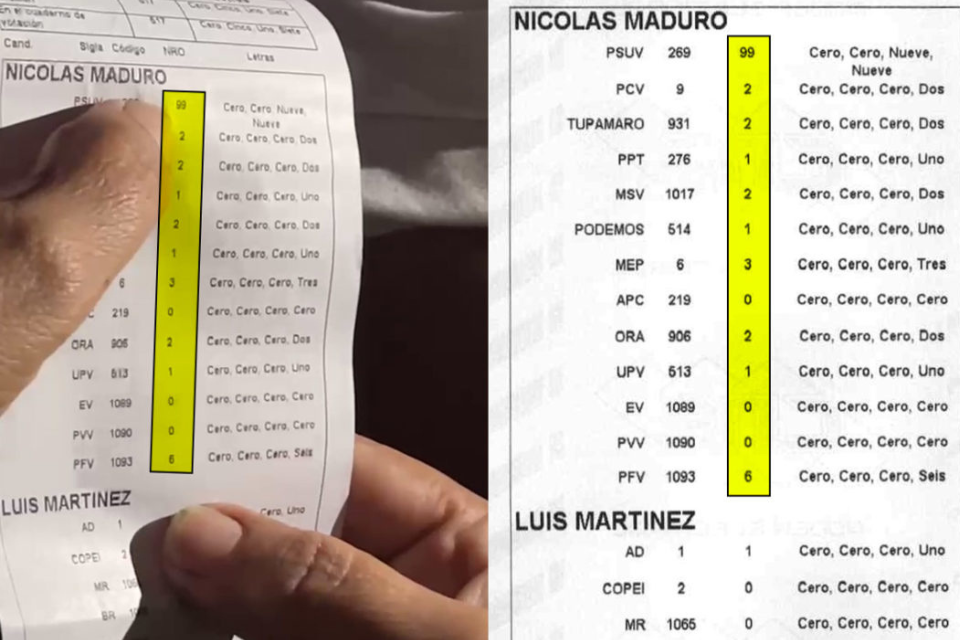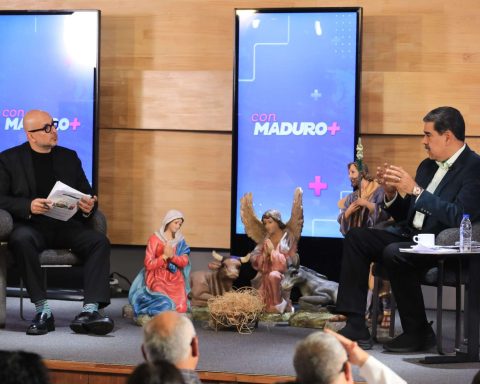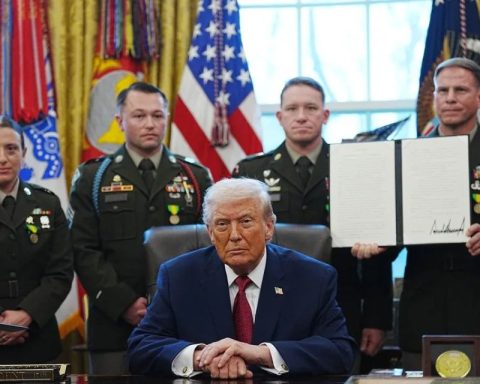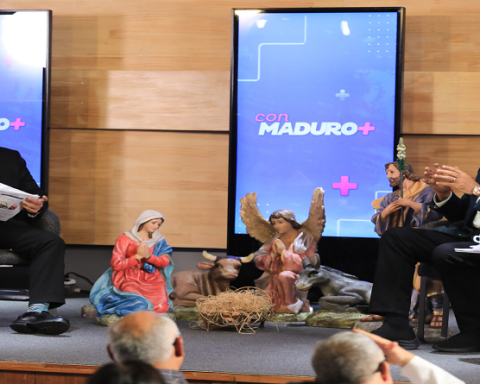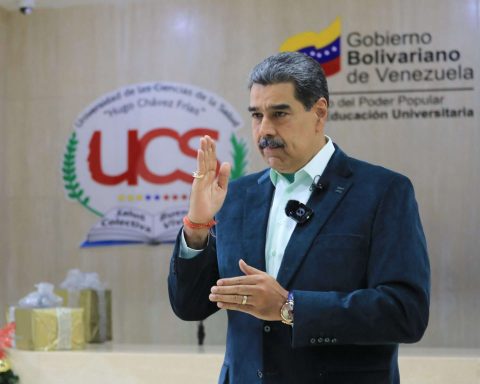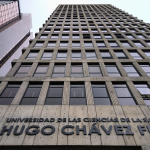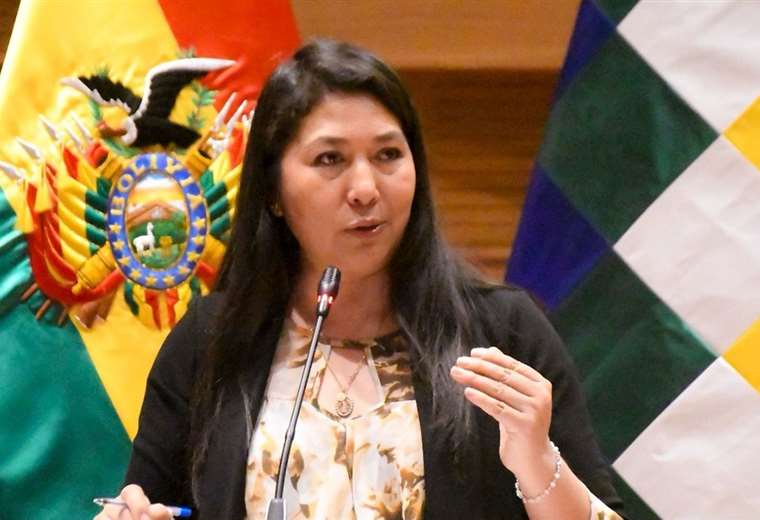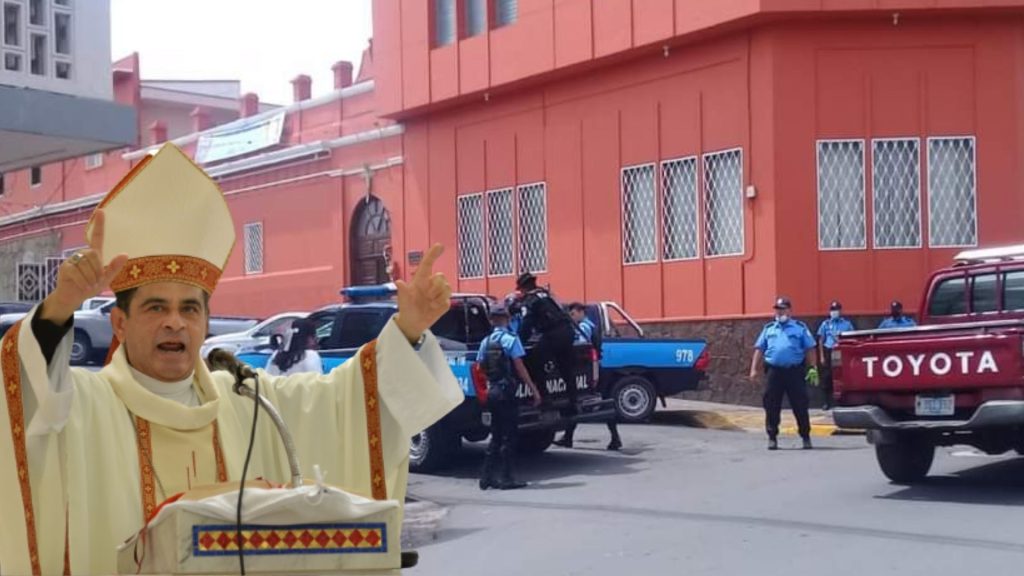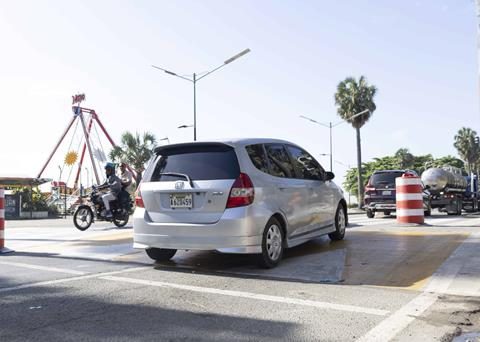Some of the results “announced” outside the voting centers on June 28, captured on video, exactly match those published on resultadosconvzla.com. Users also shared photos of the tally sheets at tables where Maduro emerged victorious and the numbers match those recorded on the website. The multiple coincidences cast doubt on the accusation by the ruling party that the tally sheets published by the opposition on the website are falsifications.
Authors: Fake News Hunters. Part of the #VenezuelaVota and #LaHoradeVenezuela initiatives
Since midnight on July 28, when the National Electoral Council (CNE) declared Nicolás Maduro the winner of the presidential elections with 51.2% of the votes, The voting records have become a key piece of political discussion. The Venezuelan opposition, represented by the Democratic Unitary Platform (PUD), contradicted this result with the publication of the scrutiny on a website that presents the detailed data with more than 80% of the voting tables, supported by the minutes collected by the opposition table witnesses and whose results favor the candidate Edmundo González Urrutia with more than 7.3 million votes67% of the total votes.
The media and citizen effect generated by the open publication of the results and minutes through resultsconvzla.com generated the reaction of the ruling party, which began to create a narrative of discrediting and criminalizing the content of the website. Through a series of accusations, the response to the initial claim has been delayed: the publication of the minutes by the CNE or the ruling party, to independently compare them with those of the opposition.
The wide gap between the CNE’s web portal and its unsupported results raised questions among regional leaders, election observers, academics, journalists and data analysts around the world. In addition to condemning the lack of transparency in the electoral process, the weakness of the ruling party’s arguments against the minutes published online by the opposition was also questioned.
“Not even with extraordinary levels of organizational capacity, conspiratorial talent, and financial muscle could a fraud have been perpetrated that would have produced the data published by the campaign, without leaving traces in the paper trail—traces that, as of the closing of this article, have not appeared,” the conclusion states. in an investigation Signed by Dorothy Kronick, Assistant Professor at the Goldman School of Public Policy at the University of California, Berkeley.
Legitimacy is debated between results without clear support from the electoral authority and the scrutiny guaranteed by the citizens Venezuelan, who is now demanding that the veracity of the content available on the website be questioned.
I know what happened last June 28th
“Maduro did not win. He lost in polling stations that —since their creation— the government had never lost, as is my case and I know this because I was there when the results of my center were read (…)”, assured one of the many social media users who were present at the time of the final count at their respective voting centers.
The presence of citizens documenting the entire process from their voting centers guaranteed a flow of content through instant messaging, social media posts, images and videos that created an indelible digital footprint that —along with the minutes posted on the website— show the intention of hide reality through the use of disinformation and propaganda. In certain cases, this has even led some eyewitnesses to doubt what they experienced.
These days I almost slapped myself. I thought: did that really happen? Was I part of a lie? For a moment I hesitated. It was a matter of seconds, but then I said to myself: wait, you were there, that happened,” said an eyewitness, reflecting on how propaganda and misinformation can shake many people’s perception of reality. She then added: “Yes, it can happen that they convince a person that what they experienced is a lie.”
Since the evening of July 28, social networks have become repository of hundreds of testimonies of people who felt, firsthand, what happened in each of their voting centers. Not only are there written testimonies, tweets and conversations circulating about the experience lived by witnesses on July 28, who heard the results at the end of the day. Dozens of photographs of the minutes, taken at the exit of the voting centers, were also published, which support the authenticity – at least of part – of the results shown on the website set up by the Venezuelan opposition.
In addition, numerous videos have been released showing the results at the close of the polls, recorded by attendees who captured the moment when the announcements were made. In some of them, those who “sang” the results mentioned both the name and location of the centeras well as the total votes obtained by the two main candidates who are the protagonists of the electoral situation: Nicolás Maduro and Edmundo González Urrutia or their parties. In other cases, The witnesses added up the scores of each table live in front of those present, who waited for hours outside their polling station to guard the vote and document on video when the results were presented.
Are the citizens’ numbers real?
Fake News Hunters compared 50 videos shared on social media, tracking the loudly announced data on results, names and locations of different polling stations, and compared them with those published on the website. resultsconvzla.comIn addition, keyword searches were conducted among 25,073 scanned records –extracted from the website–, from a Open access collection of minutes created in PinPointan artificial intelligence-based tool from Google Journalist Studio.
In the specific group of videos analyzed, the PUD candidate, Edmundo González Urrutia, appears as the winner in each announced result, surpassing the official candidate, Nicolás Maduro.
Of the videos analyzed, 18 match exactly both the results announced by the witnesses and the data published in resultsconvzla.com. The 18 audiovisual pieces – 6 of them recorded in the state of Barinas, an entity considered by the government as “the cradle of the revolution”—account for the results from 40 voting tables in different electoral centres and states.
In 9 of the 50 videos analyzed, the counts are announced publicly in the presence of military officials. Republic Planor even directly by them. The Republic Plan It is a military deployment that is carried out in all electoral processes in Venezuela and whose objective is to maintain order and security during each election.
In 9 of the 50 videos analyzed, the counts are announced publicly in the presence of military officials from the Plan República, or even directly by them.
Most of the videos were recorded outside the polling stations and at night, which in some cases made it difficult to read the results, which were sometimes calculated live by those present, reading directly from the printed minutes.
For example, in a video recorded outside the Monagas Kindergarten, in Maturín, Monagas state, the person reading the minutes dictates the number of votes obtained by Nicolás Maduro, party by party. Although in the video it can be seen that the minutes are identical to the ones obtained by the electoral committee, the person reading the minutes dictates the number of votes obtained by Nicolás Maduro, party by party. available on the websitethe person dictating the numbers makes a mistake in one figure, someone adds incorrectly obtaining a total of 120 votes instead of the 190 registered on the page. Something similar occurs in 9 other videos where the calculations, to a greater or lesser extent, do not exactly match the numbers of resultsconvzla.com.
The discrepancies in the sums can be explained as simple human errors, since many of the recordings were made informally and in front of dozens of people who wanted to hear the results.
In other audiovisuals it was not even possible Listen to the number of votes in favor of Edmundo Gonzálezdue to the jubilation of those present that occurs before the witnesses finish mentioning the result in favor of the opposition candidate. In another 23 pieces —where the results are also favorable to the opposition candidate— the corresponding record could not be found to the result “sung”because they did not specify the corresponding voting center.
The minutes of X
The phenomenon of Citizen verification and open data It also spread to X (formerly Twitter), a social network from which photographs and videos of minutes shared by the same users during the night of the elections could be recovered, which served as another point of comparison with the minutes uploaded on the website of the Unitary Platform.
On July 30, the journalist specialized in electoral issues, Eugenio Martínez, made a publication in your account on X encouraging citizen observers from all over the country to create a collaborative thread, to compare the results photos of the minutes from their voting centers with those published online. Hundreds of Venezuelans participated by giving “faith” that the results are the same or sharing the minutes of their voting tables housed in the sitealthough only 35 of them complied with Martínez’s initial request.
Fake News Hunters verified each of the tweets to which images of voting machine-printed minutes were attached, along with verification photographs or videos. Of the 35 publications with resultscoming from users from different states who attended various voting centers, only in three did the result in favor of Nicolás Maduro predominate.
For example, the three minutes of the UE Distrital Preescolar La Libertad, located in the parish of 23 de Enero, Libertador municipality of the Capital District, were published in one of the evaluated tweets. The minutes published in X for this voting center, match exactly with those loaded on the page resultsconvzla.com: 703 votes in favor of Nicolás Maduro and 692 for Edmundo González. Both candidates obtained approximately 48% of the votes, in a educational center located in an area traditionally close to Chavismo.
However, in 32 of the responses to Eugenio Martínez’s petition, the opposition candidate had an advantage over the official candidate in votes. For example, a tweet shows that in table 2 of the UE Mesa de Julia in the state of Mérida, in the Tucaní parish of the Caracciolo municipality, Edmundo González obtained 407 votes compared to 98 votes given to Nicolás Maduro. The difference in votes is also evident in the other publications.
“The ones from my polling station, tables 1 and 2, match perfectly. Same results,” said the user X who posted the photo of the tally sheets.
Despite the government’s efforts to discredit the minutes published by the opposition, videos and photos from the 28J election, captured amid the euphoria of the citizens, largely match the results shared online. This visual evidence reinforces the experiences of those who claim to have witnessed those results, contradicting the government’s accusations that the minutes and results published online are falsifications.
In an environment like Venezuela’s, where the government tries to impose its narrative through propaganda and misinformation, the demand for transparency remains in force, while a significant part of the voting population continues to question the official version of events.
Post Views: 514
